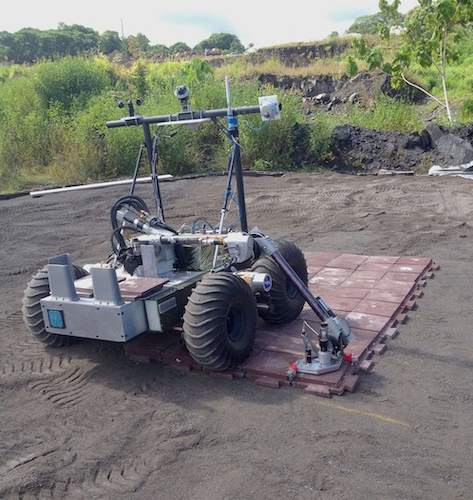How to Build Moon Bases
- 1International MoonBase Alliance & Hawai´i Space Exploration Analog and Simulation (HI-SEAS), United States (henk@tetris.com)
- 2Blue Planet Research LLC
- 3Pacific International Space Center for Exploration Systems
- 4ILEWG EuroMoonMars programme
- 5Institute of Robotics and Cybernetics, Faculty of Electrical Engineering and Information Technology STU in Bratislava, Slovakia
- 6Slovak Organisation for Space Activities (SOSA), Bratislava, Slovakia
- 7ESA ESTEC, Noordwijk & ILEWG
- 8Vrije Universiteit Amsterdam
The time for humans to return to the Moon is upon us. This time we will not just go to the moon to collect some rocks and to leave only footprints. This time we will build permanent settlements and colonize the Moon. Our plan is to enable the building of international Moon settlements. There are numerous space agencies, companies and research institutions working on building rockets that will carry payload to the moon but what we do when we get there has mainly been focused on small scale rover based exploration. It is high time we started the work of designing and building human lunar settlements. The idea is to gather all of the space agencies, companies and research institutions to work in one place where they can combine forces and robotically build prototype Moon structures and landing pads on Earth, with the goal of creating robots that will be sent to the Moon to create human settlements. The group of participants who will carry out the Research & Development is called the IMA (the International MoonBase Alliance).
Accomplishments to date:
HI-SEAS (the Hawai’i - Space Exploration Analog and Simulation):
We held five long duration Mars missions with NASA and the University of Hawaii in a habitat we designed and built on Mauna Loa, an active volcano and the biggest mountain in the world (by volume) on the Big Island of Hawaii. Each mission comprised of 6 crew staying in a 110 sq m (1,200’ sq. ft.) dome to test crew selection and crew psychology (Figure 1). If during the mission crew members left the habitat, that was considered an “Extra Vehicular Activity” (EVA). EVAs were conducted according to strict EVA rules with crew wearing analog spacesuits. All communications from the habitat to the rest of the world were delayed 20 minutes each way to simulate the lag in communicating with Mars. The missions varied between 4 to 12 months in length.
Figure 1: The HI-SEAS habitat.
In the last few years, we have pivoted from NASA Mars missions to IMA Moon missions, which are shorter in duration (from weeks or days). These missions are more about giving a larger group of people practical “off-world” experience and about testing research experiments and technologies needed to build a lunar settlement (Figure 2). We have built a “Mission Control” facility. We are testing new and much improved EVA suits equipped with 3D cameras and head-up displays to better communicate with Mission Control.
Figure 2: HI-SEAS lunar mission crewmembers performing an EVA in a lava tube.
PISCES (the Pacific International Space Center for Exploration Systems):
PISCES is a State of Hawaii R&D group. We have worked with NASA to sinter powdered Hawaii lava rock (96% the same chemistry as lunar regolith) into building materials stronger than specialty concrete. We created “pavers” which we deployed into a landing pad using a rover and tested it with a mounted rocket engine (Figures 3 & 4). Rodrigo Romo who heads up PISCES, spent 6 months in Biosphere 2 giving us a wealth of information about sealed self-sustaining environments.
Figure 3: PISCES rover testing.

Figure 4: PISCES rocket engine test.
IMS (the International MoonBase Summit):
We held the first IMS in October of 2017. 100 scientists, engineers, designers, economists, legislators, astronauts and students, gathered in Hawaii to brainstorm the first permanent lunar settlement. Out of this gathering was created the IMA. We published our findings in a book called “Mahina”, the word for Moon in Hawaiian. It is our plan to build a first Moon Settlement and call it “Mahina Lani” or “Moon Heaven”.
The plan going forward:
IMA (the International MoonBase Alliance):
The IMA plan calls for a 1,000 acre “lunar landscape” campus on which we will build lunar structure prototypes. We are now in phase one on a much smaller scale. We are building a sealed windowless 12 meter (40’) diameter dome with an airlock. Our plan is to build it out of layers of “radiation proof” cement and use spherical projection systems to simulate windows and other desirable features. We plan to conduct a series of experiments with different internal configurations to simulate crew quarters, mission control, engineering bays, food growing facilities, meeting rooms, common areas, mess halls, recycling centers and entertainment spaces.
The IMA vision is to send robots to the Moon that will 3D print structures that will be occupied by humans when the time comes. The focus will be on using ISRU (In Situ Resource Utilization) to build self sustaining lunar settlements (Space Ports). The oceanic rock of Hawaii ideal because it is the closest simile to lunar regolith that's we can find on Earth. Hawaii is also a melting pot of Asian and American cultures, so it’s the perfect place for cooperation by and between American and Asian space settlement efforts.
Let’s all work together and build a permanent lunar settlement, a MoonBase, by the end of this decade, “not because it’s easy, but because it’s hard” (quote by John F. Kennedy).
How to cite: Rogers, H., Musilova, M., Romo, R., Ponthieux, V. P., and Foing, B.: How to Build Moon Bases, Europlanet Science Congress 2020, online, 21 September–9 Oct 2020, EPSC2020-1026, https://doi.org/10.5194/epsc2020-1026, 2020

